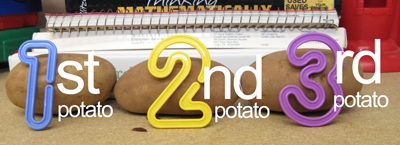 We were hanging at the playground on Mother’s day. Daughter had taken up with a cute little girl – a good playmate for the teeter-totter. I watched Daughter’s new friend do something interesting. She was “counting” some gumballs that had fallen off the sweetgum tree.
We were hanging at the playground on Mother’s day. Daughter had taken up with a cute little girl – a good playmate for the teeter-totter. I watched Daughter’s new friend do something interesting. She was “counting” some gumballs that had fallen off the sweetgum tree.
Here’s what she said: ONE TWO THREE FOUR FIVE SIX SEVEN EIGHT
I looked and there were ten gumballs. I watched her more and saw that while she was reciting the terms and pointing at the gumball pile, she wasn’t associating each number word with the next gumball in the pile.
Developmentally, I’m not sure if this is okay or not. I wonder.
Mathematically, I know that there’s still a disconnect with this girl and what numbers mean to her.
There are two types of numbers.
In the realm of counting numbers, there are two types. Cardinals and ordinals. A cardinal number tells us how many we have. Like this:

And ordinal number tells us the order:

When we count, we use both types of numbers.
 The group of gumballs has the cardinal number of 10. But to arrive at that cardinal number, to determine how many there are, the friend had to “order” them. She was trying to point to each one and assign it a position. “YOU, I label 1st, you are 2nd … and since you are 10th, I know I have 10 gumballs.”
The group of gumballs has the cardinal number of 10. But to arrive at that cardinal number, to determine how many there are, the friend had to “order” them. She was trying to point to each one and assign it a position. “YOU, I label 1st, you are 2nd … and since you are 10th, I know I have 10 gumballs.”
We grownups take advantage of this procedure. Indeed most people don’t know what cardinals and ordinals are.
But knowing this when you teach counting is quite helpful. At home you can do something similar to the potatoes in the pictures above. At school, you can buy some great posters (I found one at Teacher’s Heaven last night) that demonstrate this.
Will you change the way you think and talk about numbers?
Related articles
- Teaching Math without Rules: Addition of Positive and Negative Numbers (mathfour.com)
- Two Reasons to Memorize Math Facts (mathfour.com)
- Teaching Patterns with Playful Bath Shapes (mathfour.com)

This post may contain affiliate links. When you use them, you support us so we can continue to provide free content!







It is absolutely developmentally appropriate not to properly associate the counting words with the actual objects when children begin counting. This is part of the development of 1 to 1 correspondence between the number words and the objects and develops with practise. (daily use includes -> 2 shoes for 2 feet, a plate for each person at the dinner table, giving everyone one sweet etc)
There’s some stuff on it here: “http://www.schoolsparks.com/early-childhood-development/math-number-awareness”. I like your observation that we use both types of numbers (cardinal and ordinal) when counting. I hadn’t thought of it like that before.
One to one correspondence is also vital for reading, since children must associate a single spoken word with a printed one. So practising one-to-one correspondance, with or without counting words, helps for both reading and math. (Count 10, read 10? :D).